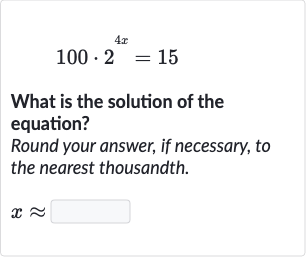Full solution
Q. What is the solution of the equation?Round your answer, if necessary, to the nearest thousandth.
- Isolate exponential term: First, we need to isolate the exponential term by dividing both sides of the equation by .
- Apply logarithm: Now, we apply the logarithm to both sides of the equation to solve for . We can use the natural logarithm () or the common logarithm (). Here, we'll use the natural logarithm for convenience.
- Move exponent in front: Using the power property of logarithms, we can move the exponent in front of the logarithm.
- Solve for x: Next, we solve for by dividing both sides of the equation by .
- Calculate x: Now, we calculate the value of x using a calculator.

